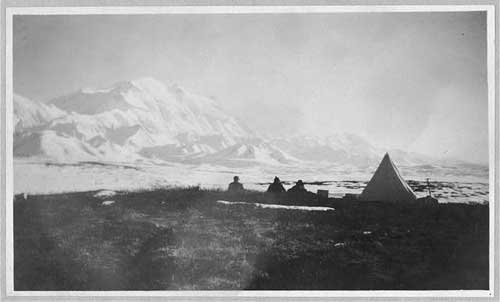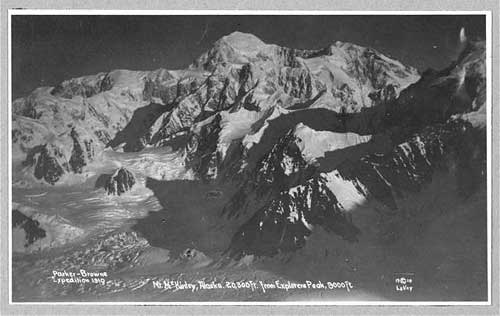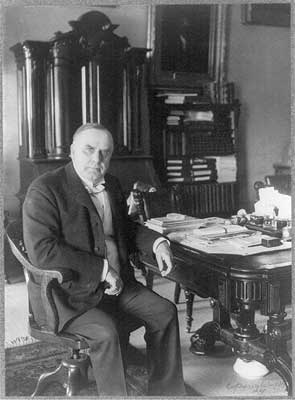 and the president it's named for By June Allen September 14, 2003
Forms part of: Frank and Frances Carpenter collection Gift; Mrs. W. Chapin Huntington; 1951. Courtesy Library of Congress
Mt. McKinley is the crowning jewel of Denali National Park which lies 235 miles north of Anchorage on the Parks Highway. But climbers and sightseers begin their personal acquaintance with the mountain from the small town of Talkeetna, which boasts an area population of 772 and is located on a 14-mile dead-end spur of the Parks highway that branches off at mile 99. Talkeetna was a gold mining supply center back in 1896, when riverboats brought supplies up the Susitna River as far as they could go. It was the rich gold supply dug from the mountain range all along that long stretch that occasioned the construction of the Alaska Railroad in those early years. So by 1915 Talkeetna became a railroad town. A hostelry in Talkeetna today boasts that in 1923, President Warren G. Harding had a drink at its bar "and no president since has," alluding whimsically to the fact that President Harding promptly died - of a still unknown cause - after his Alaska visit in 1923. Today Talkeetna, in spite of its small size, has two airports - the right-downtown one primarily used for flightseeing and flying climbers to the base camps on the mountain. The other airport is a strip that was built in WWII as a refueling stop for Lend-Lease planes being ferried from the States to Fairbanks, where Russian pilots then manned the planes to fly to Nome and on to Russia. But today's summer season activity is centered on the "downtown" Talkeetna runway, where small planes take off with climbers and deposit them at glacier airstrip on the mountain. Each year about 500 climbers try Mt. McKinley and an average of three die in the attempt. Climbers have been scaling Mt. McKinley from the earliest days of white settlement of Alaska - but in much smaller numbers back then. But among Alaska residents, Sourdoughs, politicians and visitors there is a difference of opinion about what the name of that popular 20-thousand-foot-plus Alaska mountain is or
Successfully submitting the president's name for the mountain to the proper U.S. agency and officials is historically attributed to a man named William A. Dickey, sometimes referred to as an Alaska prospector from Ohio, who had been lured to Alaska in 1896 by news accounts of gold discoveries in Alaska's Cook Inlet region. At that time there was already regular steamship service to the town of Knik on the Inlet. (Years later, Anchorage would be founded across the Inlet from Knik and become Alaska's largest city, Anchorage.) The story goes that gold-seeker Dickey and three companions arrived in Talkeetna and saw the massive mountain. That's probably true, but perhaps Dickey was more newspaperman than prospector? At any event, when he returned to New York not long after his Alaska experience, he wrote a popular and much-read account of his Gold Rush journey and the memorable mountain; it was published in the New York Sun. And he is credited for naming Mt. McKinley. No one argued the officially given name of Mount McKinley for the next seventy years or so. The mountain was named for the 25th President of the United States, William McKinley, who was elected to the nation's highest office in 1896 and re-elected in 1900, only to be assassinated in 1901 by a lone "anarchist" - an early 20th century term for "terrorist." Some of today's political activists, who insist that the name Denali is more appropriate, cite the fact that "Most Americans don't rank President McKinley very high in the pantheon of presidents - they remember him, if at all, as a creation of Ohio political boss Mark Hanna, beholden to big business, and addicted to high tariffs." In fact, however, William McKinley was a much-admired man who was first a lawyer, an Ohio legislator, later a two-term Ohio governor, and then a politically moderate Republican president. He was the last of the Civil War heroes to serve in the nation's highest office. He was chief executive during the recovery of the nation from the devastating 1893 depression. He was president when the world first heard the news of the Gold Rush and the tales of gold nuggets lying on the ground and waiting for discovery in the far north. He was a popular gentleman whose professional skills at negotiation and compromise were said to be equaled by his impressive physical presence and legendary courtesy. He served at a time in history of great awareness of the United States' role in world history. It was then that the brief Spanish-American was fought and the Philippines and Puerto Rica came under the U.S. flag - ending the nation's long-standing isolationist stance in world affairs. The west was won and the nation stretched from coast to coast. Everything was on the cusp of change. The new McCormick reaper was available for large-scale farming. There were trans-continental railroads in service. It was also a time of awakening to the impressive American technological accomplishments - telephones, telegraphs, electric lights, moving pictures, oil wells and petroleum products, automobiles and soon-to-be aircraft, with radio just around the corner. Throughout his public service McKinley is said to have enjoyed support from both corporations and the working man - almost everyone. And he was assassinated, and there is the fact that assassinated presidents are long remembered.  Forms part of: Frank and Frances Carpenter collection Gift; Mrs. W. Chapin Huntington; 1951. Courtesy Library of Congress
The exposition was a grand affair spreading over spacious grounds, with a Grand Canal, long "streets" of exhibit buildings, an electric tower and even a Wild West Show. The grounds of that exposition are an open and lovely grassy park to this day - home to the famous Albright Knox Art Gallery founded in 1862. The President on that autumn day of 1901 was to give a speech after a reception at the Music Building. He was standing at a receiving line while greeting the public when an anarchist named Leon Czolgosz, holding a handkerchief over the gun he held, shot the President twice at point blank range. McKinley was taken by carriage to a nearby private home where he was treated by doctors. At first it was thought that he would survive, but infection set in and he died eight days later, Sept. 14, 1901, whispering to himself the words of the hymn Nearer My God to Thee. That unhappy event made the 42-year-old Teddy Roosevelt, hero of the Spanish-American War, the new President. One commentator is reported to have said, "Now look! That damned cowboy is president of the Unites States!" And that's the story of the president for whom Alaska's Mt. McKinley is named. It was a name that was accepted without question until the ferment and protest movements of the 1970s became part of the political scene. Those who protested the mountain's name at the time called the early naming of the mountain "cultural imperialism" and lobbied for the name to be changed back to that used by the Tanaina Indians, Denali. According to Indian legend, it was asserted, nearby Mt. Foraker should be called, as the Native Alaskans called it, Mother of Denali, and Mt. Hunter should rightly be called Child of Denali. Some of the Native Alaska community joined the protest and lobbied for the mountain's name change. But in the eyes of the federal government the mountain remains Mt. McKinley with or without (Denali) appended. The Alaska Legislature addressed the issue on several occasions and the pendulum swung back and forth. And about the same time, a poetess in Fairbanks penned a poem that began, "Golly, golly, Mount Denali" I wish I could remember the rest of it.
june@sitnews.org
All rights reserved. Not to be reprinted in any form without the written permission of June Allen.
|
||||||||






